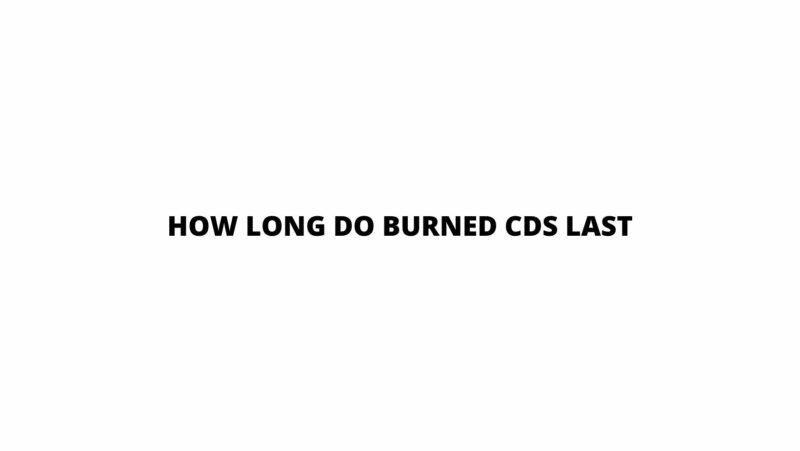In the digital age, where data preservation is of paramount importance, burned Compact Discs (CDs) have emerged as a favored medium for archiving, distributing, and sharing content. However, the question of how long burned CDs last looms over their relevance and utility. As we entrust these discs with cherished memories, valuable information, and creative endeavors, it’s essential to understand the factors that influence the lifespan of burned CDs. This article delves deep into the intricacies of CD burning, the mechanisms behind CD degradation, and strategies to ensure the extended longevity of these digitally crafted relics.
- The Craft of Burning CDs
Burning a CD involves the process of writing digital data onto a blank disc, creating a recordable or rewritable disc for storing various types of content. The process of CD burning involves using a laser to etch microscopic pits and lands onto the disc’s dye layer. These pits and lands represent the binary code of the digital data, which is read by CD players and drives.
- Quality of CD-R Discs: A Crucial Factor
The longevity of burned CDs is closely tied to the quality of the CD-R (recordable) discs used in the burning process. The dye layer in CD-R discs is crucial, as it plays a central role in storing data. High-quality CD-R discs contain a more stable and durable dye layer that is less susceptible to degradation over time. Opting for reputable brands and discs with a gold or silver reflective layer can enhance the potential lifespan of burned CDs.
- Environmental Factors: Guardians of Longevity
The lifespan of burned CDs is significantly influenced by the environment in which they are stored and used. Exposure to specific environmental factors can accelerate the degradation process:
- Temperature: Extreme temperatures, both hot and cold, can cause the dye layer to deteriorate more rapidly, leading to potential data loss.
- Humidity: High humidity levels can foster the growth of mold on the disc’s surface or trigger chemical reactions within the dye layer, compromising data integrity.
- Light Exposure: Prolonged exposure to direct sunlight or artificial light can degrade the dye layer, particularly in poorly manufactured or low-quality CD-R discs.
- Contaminants: Dust, dirt, and contaminants can scratch the disc’s surface, which can damage the dye layer and interfere with data readability.
- Degradation Mechanisms: Peeling the Layers
The degradation of burned CDs is a multifaceted process influenced by several mechanisms:
- Chemical Degradation: Over time, the materials used in CD-R discs can undergo chemical reactions that lead to the deterioration of the dye layer. This degradation can result in the loss of data integrity.
- Physical Damage: Scratches, fingerprints, and physical damage can compromise the dye layer’s integrity, rendering data unreadable.
- Oxidation: Exposure to oxygen can lead to oxidation of the reflective layer, affecting data readability by reducing the laser’s ability to read pits and lands.
- Empirical Studies: The Quest for Answers
Numerous studies and experiments have been conducted to determine the potential lifespan of burned CDs. The outcomes vary widely due to factors such as the quality of the CD-R discs, storage conditions, handling practices, and the specific types of dyes used in the discs. Some studies suggest that well-manufactured CD-Rs, stored under controlled conditions, can potentially last for several decades.
- Preservation Strategies: Nurturing CD Longevity
To ensure the extended lifespan of burned CDs, consider the following preservation strategies:
- Storage Conditions: Store CDs in a controlled environment with stable temperature and humidity levels. Avoid exposing them to direct sunlight, moisture, and extreme temperatures.
- Handling Practices: Handle CDs with care, holding them by the edges and avoiding touching the data side. Store them vertically in protective cases to prevent scratches and physical damage.
- Cleaning: Clean CDs gently using a microfiber cloth or a specialized cleaning solution. Avoid abrasive materials that can scratch the surface or harsh chemicals that can damage the dye layer.
- Digitization: Consider digitizing the content of burned CDs by transferring it to modern storage solutions, such as hard drives or cloud storage. This approach adds an extra layer of protection against physical degradation.
- Technological Trends: A Shift in the Landscape
As technology continues to evolve, alternative storage solutions, such as solid-state drives (SSDs), cloud storage, and digital streaming platforms, have gained prominence. These solutions offer advantages in terms of accessibility, convenience, and durability compared to physical media like CDs.
Conclusion
The lifespan of burned CDs is a delicate interplay of factors ranging from the quality of CD-R discs and the environment to chemical reactions and handling practices. While well-manufactured and properly stored CD-R discs have the potential to endure for years, their longevity is not guaranteed. To preserve cherished memories, essential data, and creative endeavors stored on burned CDs, adopting proactive preservation strategies is crucial.
As technology continues to advance and new storage solutions emerge, it’s essential to embrace evolving formats while appreciating the legacy of burned CDs as a tangible link to our digital past. Ultimately, the lifespan of burned CDs is a balance between preservation efforts, technological trends, and the enduring value of preserving content for generations to come.

